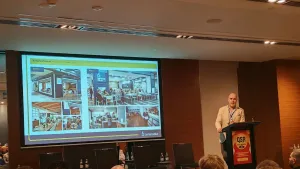
How dynamic digital menu boards are changing the pricing game
Oracle Food & Beverage makes a case for brands choosing a menu board solution that integrates with a POS system.
Basically all outlets in the restaurant business use menu boards, for good reason. They are simple, cheap, and do an effective, straightforward job of telling customers what’s on offer on a particular day and for how much.
But in an era of digital convenience and instant information, not being able to quickly change what the menu boards display can bring an unnecessary amount of hassle into the already difficult job of managing a restaurant.
Especially when it comes to pricing. Unexpected changes in the supply of seasonal produce, fluctuations cost of goods, competition, consumer demand, even the time of day can affect the cost of menu items.
And for every change made to a dish, item, price or picture, the menu board would need updating. That might not be a problem for a small independent store, but it is a massive cost for a QSR chain with hundreds of outlets.
Fortunately, there is an easy solution.
Digital menu boards nowadays are dynamic enough to have real-time availability and be able to change their content according to your particular needs. Being completely digital and remotely managed through your POS system, these dynamic menu boards have displays that can change according to the time of day and day of the week, reflecting price and menu updates on the fly.
The cutting edge LED displays can also serve to engage and attract customers with quality imagery and rich content. Through strong and enticing graphics, brands can easily display popular items that consumers would want to order, as well as any ongoing promotions and specials that they may not know of. There is also the possibility of upselling customers to provide better value.
Using digital menu boards for your business
Digital menu boards can be linked to your restaurant’s POS system to ensure the pricing displayed is correct, the appropriate menu items are available, along with the set deals and promotions for a particular time or date.
Being centrally managed through a unified system, digital menu boards provide the perfect solution for QSRs and multi-chain restaurants. By managing the displays through your POS system, changes to the menu can be simple, quick, and precise, all without the added labor costs and complexities of changing them manually.
For optimal use, however, Fiona Southam, Sales Director ANZ at Oracle Food and Beverage, advises brands to choose a menu board solution that integrates with the POS system to minimise duplication of content and to facilitate automatic changes to meal period changes based on the time of day (e.g. switching from breakfast to lunch menu). Choosing a dynamic menu board solution which allows for rich digital media will also allow for versatility and flexibility in driving special marketing campaigns and promotions.
Southam adds that brands should also watch out for displaying content that changes too frequently as it makes it hard for the customer to view the menu and select the item they want.
“Some low end solutions will not allow a lot of the dynamic features. Lack of integration with POS means maintaining two systems – this makes consistency of pricing and offerings a challenge,” she said.


























